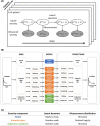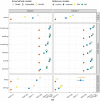EczemaPred: A computational framework for personalised prediction of eczema severity dynamics
- PMID: 35344305
- PMCID: PMC8967258
- DOI: 10.1002/clt2.12140
EczemaPred: A computational framework for personalised prediction of eczema severity dynamics
Abstract
Background: Atopic dermatitis (AD) is a chronic inflammatory skin disease leading to substantial quality of life impairment with heterogeneous treatment responses. People with AD would benefit from personalised treatment strategies, whose design requires predicting how AD severity evolves for each individual.
Objective: This study aims to develop a computational framework for personalised prediction of AD severity dynamics.
Methods: We introduced EczemaPred, a computational framework to predict patient-dependent dynamic evolution of AD severity using Bayesian state-space models that describe latent dynamics of AD severity items and how they are measured. We used EczemaPred to predict the dynamic evolution of validated patient-oriented scoring atopic dermatitis (PO-SCORAD) by combining predictions from the models for the nine severity items of PO-SCORAD (six intensity signs, extent of eczema, and two subjective symptoms). We validated this approach using longitudinal data from two independent studies: a published clinical study in which PO-SCORAD was measured twice weekly for 347 AD patients over 17 weeks, and another one in which PO-SCORAD was recorded daily by 16 AD patients for 12 weeks.
Results: EczemaPred achieved good performance for personalised predictions of PO-SCORAD and its severity items daily to weekly. EczemaPred outperformed standard time-series forecasting models such as a mixed effect autoregressive model. The uncertainty in predicting PO-SCORAD was mainly attributed to that in predicting intensity signs (75% of the overall uncertainty).
Conclusions: EczemaPred serves as a computational framework to make a personalised prediction of AD severity dynamics relevant to clinical practice. EczemaPred is available as an R package.
Keywords: Bayesian model; PO-SCORAD; atopic dermatitis; machine learning; prediction.
© 2022 The Authors. Clinical and Translational Allergy published by John Wiley & Sons Ltd on behalf of European Academy of Allergy and Clinical Immunology.
Conflict of interest statement
Sophie Mery, Alain Delarue, Markéta Saint Aroman and Gwendal Josse are employees of Pierre Fabre Laboratories. Guillem Hurault, Jean François Stalder and Reiko J. Tanaka have no conflicts to disclose.
Figures





Similar articles
-
Validation of five patient-reported outcomes for atopic dermatitis severity in adults.Br J Dermatol. 2020 Jan;182(1):104-111. doi: 10.1111/bjd.18002. Epub 2019 Jul 24. Br J Dermatol. 2020. PMID: 30972740
-
Comparison of Patient-Oriented Eczema Measure and Patient-Oriented Scoring Atopic Dermatitis vs Eczema Area and Severity Index and other measures of atopic dermatitis: A validation study.Ann Allergy Asthma Immunol. 2020 Jul;125(1):78-83. doi: 10.1016/j.anai.2020.03.006. Epub 2020 Mar 18. Ann Allergy Asthma Immunol. 2020. PMID: 32199977
-
Patient-Oriented SCORAD (PO-SCORAD): a new self-assessment scale in atopic dermatitis validated in Europe.Allergy. 2011 Aug;66(8):1114-21. doi: 10.1111/j.1398-9995.2011.02577.x. Epub 2011 Mar 18. Allergy. 2011. PMID: 21414011
-
Practical issues on interpretation of scoring atopic dermatitis: the SCORAD index, objective SCORAD and the three-item severity score.Br J Dermatol. 2007 Oct;157(4):645-8. doi: 10.1111/j.1365-2133.2007.08112.x. Epub 2007 Aug 21. Br J Dermatol. 2007. PMID: 17714568 Review.
-
Patient-reported outcome (PRO) instruments for disease severity and quality of life in patients with atopic dermatitis: a systematic review of English and Chinese literature.Ann Transl Med. 2022 Aug;10(16):906. doi: 10.21037/atm-22-3164. Ann Transl Med. 2022. PMID: 36111032 Free PMC article. Review.
Cited by
-
Artificial Intelligence: Exploring the Future of Innovation in Allergy Immunology.Curr Allergy Asthma Rep. 2023 Jun;23(6):351-362. doi: 10.1007/s11882-023-01084-z. Epub 2023 May 9. Curr Allergy Asthma Rep. 2023. PMID: 37160554 Free PMC article. Review.
References
-
- Weidinger S, Novak N. Atopic dermatitis. Lancet. 2016;387(10023):1109–1122. - PubMed
-
- Bieber T, D’Erme AM, Akdis CA, et al. Clinical phenotypes and endophenotypes of atopic dermatitis: where are we, and where should we go? J Allergy Clin Immunol. 2017;139(4):S58–S64. - PubMed
-
- Hurault G, Domínguez‐Hüttinger E, Langan SM, Williams HC, Tanaka RJ. Personalized prediction of daily eczema severity scores using a mechanistic machine learning model. Clin Exp Allergy. 2020;50(11):1258–1266. - PubMed
-
- Tofte S, Graeber M, Cherill R, Omoto M, Thurston M, Hanifin JM. Eczema area and severity index (EASI): a new tool to evaluate atopic dermatitis. J Eur Acad Dermatol Venereol. 1998;11:S197. - PubMed
Grants and funding
LinkOut - more resources
Full Text Sources

